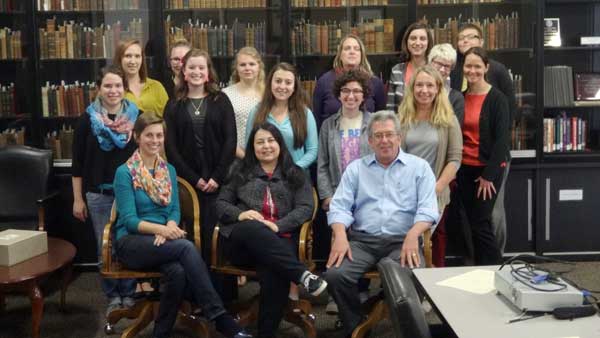Psychology in the archives

There’s a lot to be learned from a cow puzzle.
At least that’s what renowned psychologist Eric Schopler discovered during his research with the aid of a simple cow-shaped puzzle and a traditional puzzle with different interconnecting pieces and a scrambled image.
Children with autism were able to complete the traditional puzzle with the scrambled image faster than non-autistic children, Schopler found. While the non-autistic children relied on visual cues, the autistic children relied on their sense of touch to complete both puzzles. The finding suggested to Schopler that children with autism approach the world in different ways and that it was important to respect these differences when creating therapeutic approaches for children with autism.
Seven students in Psychology Professors Erin Hahn and Michelle Horhota’s May Experience course spent three weeks getting into the mind of Schopler as part of their visit to the Cummings Center for the History of Psychology at the University of Akron in Ohio.
It all started when the Center’s director, David Baker, visited Furman two years ago for a special symposium celebrating the 100-year anniversary of John B. Watson’s journal article, “Psychology as the Behaviorist Views It,” in Psychological Review.
After “nerding out” upon hearing Baker’s descriptions of all the classic artifacts available there, Hahn and Horhota began discussions with Baker about how they could arrange a visit to the Center as the basis of a unique new May Experience course, “Psychology in the Archives.”
Hahn and Horhota received four suggestions of potential student projects from the Center and polled Furman students to ask which project interested them the most.
Their choice? A collection of manuscripts, conference presentations, awards, photographs, and personal and professional correspondence from the late Eric Schopler (1927-2006), a German born American psychologist whose pioneering research into autism led to the foundation of the Treatment and Education of Autistic and related Communication-handicapped Children (TEACCH) program.
The TEACCH program, now used as a model for autism programs around the world, is unique in its use of parents as co-therapists in the process, the use of structured teaching to encourage independence and its respect for “characteristic patterns of thinking and behavior that are seen in individuals with Autism Spectrum Disorder,” according to the TEACCH website.
Students’ assignment? Process the donated Schopler collection, all 28 boxes full, into organized acid-free archival files for the Center’s archive.
For some, sorting through that much paperwork might seem like a chore. Not so, said Alyssa Ciurlik ’18.
“The excitement of Dr. Hahn and Dr. Horhota… is what sold me on the experience,” said Ciurlik of Clover, S.C. “I am a born organizer so creating order out of nearly 30 disorganized boxes sounded like fun from the beginning.”
As they spread out the mountains of paperwork into categories across multiple tables, they also found other treasures, such as Schopler’s partially-completed cow puzzle and letters to musician James Taylor and former President Jimmy Carter.
In addition to learning about Schopler as a person, students were able to see the volume of work that Schopler produced over the course of his career. This included more than 200 articles, editorial work, letters and documents describing active participation and leadership roles in national organizations and presentations given around the world. The students also saw the development of Schopler’s ideas through comments on drafts of papers, and early versions of scales and measurement tools he created.
“In addition to learning archiving skills, I was immersed into the world of Dr. Schopler,” Ciurlik said. “I learned how to look holistically at a person of history and see beyond just their accolades and academic contributions.”
The archival process took two full weeks of work and filled 61 new boxes. As part of the project, students are also creating a feature on Schopler for the Furman University Scholar Exchange (FUSE) page.
“It was excellent knowing what we were doing is incredibly valuable to not only to the archivists and future researchers, but that our work will be in the Center’s archives for a few hundred years,” said Dov Tennenbaum of Lincolnshire, Ill., ’17. “It really makes me think about the complex nature of psychology, research, the creation of ideas and their contexts. Truly, I appreciate the iceberg-like nature of what’s behind research papers and textbooks and how those influence society.”
Students participating included Kieran Cook ’17, Jenn Duer ’16, Alyssa Ciurlik ’18, Mary Lewis ’18, Addie Tapp ’18, Dov Tennenbaum ’17 and Alissa Willmerdinger ’16.
Read more about their May X experience at: http://blogs.furman.edu/psy150/